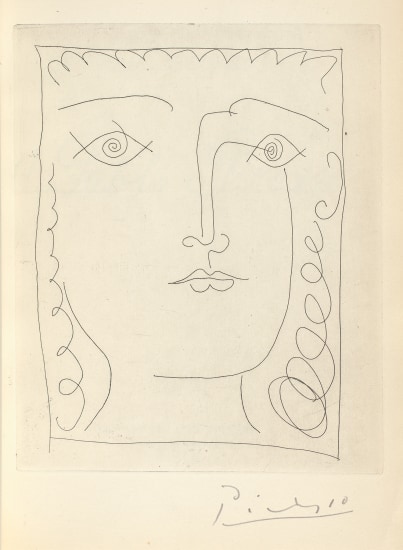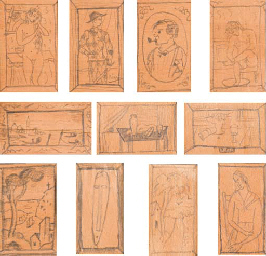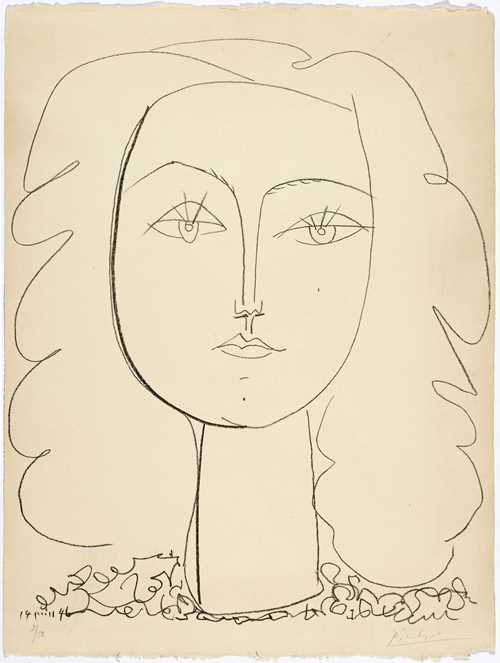Pablo Picasso Buste de Mousquetaire 1968 oil on panel 32 x 23 7/8 in. (81.4 x 60.8 cm) Signed "Picasso" left corner; dated "6.2. 68." left center.
Provenance Galerie Louise Leiris, Paris. Private Collection, acquired from the above, October 12, 1968 Private Collection, by descent from the above Christie's, London, Impressionist and Modern Day Sale, February 7, 2006, lot 343 Richard Green Gallery, London Private Collection Exhibited Geneva, Musée d'Art Moderne, Picasso, Passion et création, Les 30 dernières années, July - October 1998 Literature C. Zervos, Pablo Picasso Oeuvres de 1967 et 1968, vol. 27, Paris: Éditions Cahiers D'Art, 1973, no. 219, p. 85 (illustrated) Passion et création, Les 30 dernières années, exh. cat., Musée d'Art Moderne, Geneva, 1998, no. 32 Picasso Project, ed., Picasso's Paintings, Watercolors, Drawings and Sculpture: The Sixties III 1968-1969, San Francisco, 2003, no. 68-054, p. 17 (illustrated) Catalogue Essay Frustrated by the desperate working conditions he faced in Paris during the War years, Picasso retreated to the south of France with his muse Françoise Gilot Unlike the gray skies that invaded his Parisian studio earlier in his career, the sunlight of the Cote d’azure literally changed the artist’s palette. Picasso changed residences and studios from time to time in order to escape from his muses as well as flee from the encroachment of increasing population in the towns he dwelled. It was not until 1961 that he settled into his final home, Notre Dame de Vie, in Mougins where working conditions there were far more to his liking. His new home provided much needed seclusion, where he could focus on painting. Indeed, it was during the period of the 1960s, an intensely productive time, when Picasso produced many of his most revelatory paintings. At Notre Dame de Vie, he would spend the remainder of his days with his wife, Jacqueline Roque. Together they renewed old friendships with dealers, scholars and artists including, one in particular, the renowned photographer David Douglas Duncan It was Douglas Duncan who would be responsible for documenting the twilight years of Picasso, both in the studio, recording the master’s artistic production, as well as capturing the tender moments outside the atelier with his wife and entourage. Although Picasso had admired and reinterpreted the works of Velázquez, Rembrandt, Goya, and Manet, amongst others, it was not until the 1960s when he actively set out to acquaint himself with the famed Musketeer and other court subjects associated with the Old Masters. His earliest foray into the theme of the Musketeer was in 1962, when Picasso began painting the present work. In 1967 he executed a number of pencil drawings of the same theme (Zervos, vol. XXV, nos. 246, 257, 258). The present lot, Buste de Mousquetaire, with its protagonist adorned in a plum coiffure and intense and unerring gaze, encapsulates the artist’s unparalleled commitment to challenging not only his own stylization, but also the viewer’s very intimate and very real relationship with a portrait. In Le Mousquetaire, 1967, Picasso inscribed the reverse side of the work Domenico Theotocopulus van Rijn da Silva. By providing direct references of the Old Masters to his own work, Picasso anointed himself as the heir to the throne in the long line of great painters who preceded him, among them El Greco Rembrandt and Diego Velázquez Indeed, in the canon of works produced by the aforementioned painters, Francisco de Goya and Edouard Manet also provided source material for Picasso to explore. Given Picasso joy for hosting parties in which he and his guests wore elaborate costumes, it comes as no surprise that the artist produced his likeness in not only his depictions of Musketeers, but more blatantly in his self-referential Peintres series where the sitter was adorned in the trappings of Old Master painters he so much admired. These introspective works open a window into the artist’s psyche that provides a glimpse into Picasso’s own regard for his place in art history. Not surprisingly, the last decade of Picasso’s life was a time during which he p
Pablo Picasso Buste de Mousquetaire 1968 oil on panel 32 x 23 7/8 in. (81.4 x 60.8 cm) Signed "Picasso" left corner; dated "6.2. 68." left center.
Provenance Galerie Louise Leiris, Paris. Private Collection, acquired from the above, October 12, 1968 Private Collection, by descent from the above Christie's, London, Impressionist and Modern Day Sale, February 7, 2006, lot 343 Richard Green Gallery, London Private Collection Exhibited Geneva, Musée d'Art Moderne, Picasso, Passion et création, Les 30 dernières années, July - October 1998 Literature C. Zervos, Pablo Picasso Oeuvres de 1967 et 1968, vol. 27, Paris: Éditions Cahiers D'Art, 1973, no. 219, p. 85 (illustrated) Passion et création, Les 30 dernières années, exh. cat., Musée d'Art Moderne, Geneva, 1998, no. 32 Picasso Project, ed., Picasso's Paintings, Watercolors, Drawings and Sculpture: The Sixties III 1968-1969, San Francisco, 2003, no. 68-054, p. 17 (illustrated) Catalogue Essay Frustrated by the desperate working conditions he faced in Paris during the War years, Picasso retreated to the south of France with his muse Françoise Gilot Unlike the gray skies that invaded his Parisian studio earlier in his career, the sunlight of the Cote d’azure literally changed the artist’s palette. Picasso changed residences and studios from time to time in order to escape from his muses as well as flee from the encroachment of increasing population in the towns he dwelled. It was not until 1961 that he settled into his final home, Notre Dame de Vie, in Mougins where working conditions there were far more to his liking. His new home provided much needed seclusion, where he could focus on painting. Indeed, it was during the period of the 1960s, an intensely productive time, when Picasso produced many of his most revelatory paintings. At Notre Dame de Vie, he would spend the remainder of his days with his wife, Jacqueline Roque. Together they renewed old friendships with dealers, scholars and artists including, one in particular, the renowned photographer David Douglas Duncan It was Douglas Duncan who would be responsible for documenting the twilight years of Picasso, both in the studio, recording the master’s artistic production, as well as capturing the tender moments outside the atelier with his wife and entourage. Although Picasso had admired and reinterpreted the works of Velázquez, Rembrandt, Goya, and Manet, amongst others, it was not until the 1960s when he actively set out to acquaint himself with the famed Musketeer and other court subjects associated with the Old Masters. His earliest foray into the theme of the Musketeer was in 1962, when Picasso began painting the present work. In 1967 he executed a number of pencil drawings of the same theme (Zervos, vol. XXV, nos. 246, 257, 258). The present lot, Buste de Mousquetaire, with its protagonist adorned in a plum coiffure and intense and unerring gaze, encapsulates the artist’s unparalleled commitment to challenging not only his own stylization, but also the viewer’s very intimate and very real relationship with a portrait. In Le Mousquetaire, 1967, Picasso inscribed the reverse side of the work Domenico Theotocopulus van Rijn da Silva. By providing direct references of the Old Masters to his own work, Picasso anointed himself as the heir to the throne in the long line of great painters who preceded him, among them El Greco Rembrandt and Diego Velázquez Indeed, in the canon of works produced by the aforementioned painters, Francisco de Goya and Edouard Manet also provided source material for Picasso to explore. Given Picasso joy for hosting parties in which he and his guests wore elaborate costumes, it comes as no surprise that the artist produced his likeness in not only his depictions of Musketeers, but more blatantly in his self-referential Peintres series where the sitter was adorned in the trappings of Old Master painters he so much admired. These introspective works open a window into the artist’s psyche that provides a glimpse into Picasso’s own regard for his place in art history. Not surprisingly, the last decade of Picasso’s life was a time during which he p


.jpg?w=400)
.jpg?w=400)
.jpg)


.jpg?w=400)

.jpg)
.jpg)



.jpg?w=400)
Testen Sie LotSearch und seine Premium-Features 7 Tage - ohne Kosten!
Lassen Sie sich automatisch über neue Objekte in kommenden Auktionen benachrichtigen.
Suchauftrag anlegen